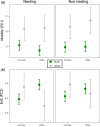Spur-winged lapwings show spatial behavioural types with different mobility and exploration between urban and rural individuals
- PMID: 39772959
- PMCID: PMC11706648
- DOI: 10.1098/rspb.2024.2471
Spur-winged lapwings show spatial behavioural types with different mobility and exploration between urban and rural individuals
Abstract
Understanding how wildlife responds to the spread of human-dominated habitats is a major challenge in ecology. It is still poorly understood how urban areas affect wildlife space-use patterns and consistent intra-specific behavioural differences (i.e. behavioural types; BTs), which in turn shape various ecological processes. To address these questions, we investigated the movements of a common resident wader, the spur-winged lapwing (Vanellus spinosus), hypothesizing that urban individuals will be more mobile than rural ones. We used an ATLAS tracking system to track many (n = 135) individuals at a high resolution over several months each. We first established that daily movement indices show consistent differences among individuals, acting as spatial-BTs. Then focusing on the two main principle components of lapwings' daily movements-mobility and position along the exploration-exploitation gradient-we investigated how these BTs are shaped by urbanization, season (nesting versus non-nesting) and sex. We found that urban lapwings were indeed more mobile in both seasons. Furthermore, urban females were less explorative than rural females, especially during the nesting season. These results highlight how urbanization affects wildlife behaviour, even of apparently urban-resilient avian residents. This underscores the need to consider possible behavioural consequences that are only apparent through advanced tracking methods.
Keywords: HIREC; biotelemetry; exploration–exploitation trade-off; movement ecology; waders.
Conflict of interest statement
We declare we have no competing interests.
Figures




Similar articles
-
Beyond simple habituation: Anthropogenic habitats influence the escape behaviour of spur-winged lapwings in response to both human and non-human threats.J Anim Ecol. 2023 Feb;92(2):417-429. doi: 10.1111/1365-2656.13858. Epub 2022 Dec 15. J Anim Ecol. 2023. PMID: 36477653 Free PMC article.
-
Consumer resource matching in urbanizing landscapes: are synanthropic species over-matching?Ecology. 2008 Feb;89(2):515-21. doi: 10.1890/07-0358.1. Ecology. 2008. PMID: 18409440
-
Small mammals in the big city: Behavioural adjustments of non-commensal rodents to urban environments.Glob Chang Biol. 2020 Nov;26(11):6326-6337. doi: 10.1111/gcb.15304. Epub 2020 Aug 27. Glob Chang Biol. 2020. PMID: 32767603
-
Behavioural responses of wildlife to urban environments.Biol Rev Camb Philos Soc. 2013 Aug;88(3):537-49. doi: 10.1111/brv.12012. Epub 2012 Dec 24. Biol Rev Camb Philos Soc. 2013. PMID: 23279382 Review.
-
Behavioural valuation of landscapes using movement data.Philos Trans R Soc Lond B Biol Sci. 2019 Sep 16;374(1781):20180046. doi: 10.1098/rstb.2018.0046. Epub 2019 Jul 29. Philos Trans R Soc Lond B Biol Sci. 2019. PMID: 31352884 Free PMC article. Review.
References
-
- Meyer WB, Turner BL. 1992. Human population growth and global land-use/cover change. Annu. Rev. Ecol. Syst. 23, 39–61. (10.1146/annurev.es.23.110192.000351) - DOI
-
- Mcdonald RI, Kareiva P, Forman RTT. 2008. The implications of current and future urbanization for global protected areas and biodiversity conservation. Biol. Conserv. 141, 1695–1703. (10.1016/j.biocon.2008.04.025) - DOI
-
- McDonnell MJ, Hahs AK. 2015. Adaptation and adaptedness of organisms to urban environments. Annu. Rev. Ecol. Evol. Syst. 46, 261–280. (10.1146/annurev-ecolsys-112414-054258) - DOI
MeSH terms
Grants and funding
LinkOut - more resources
Full Text Sources

